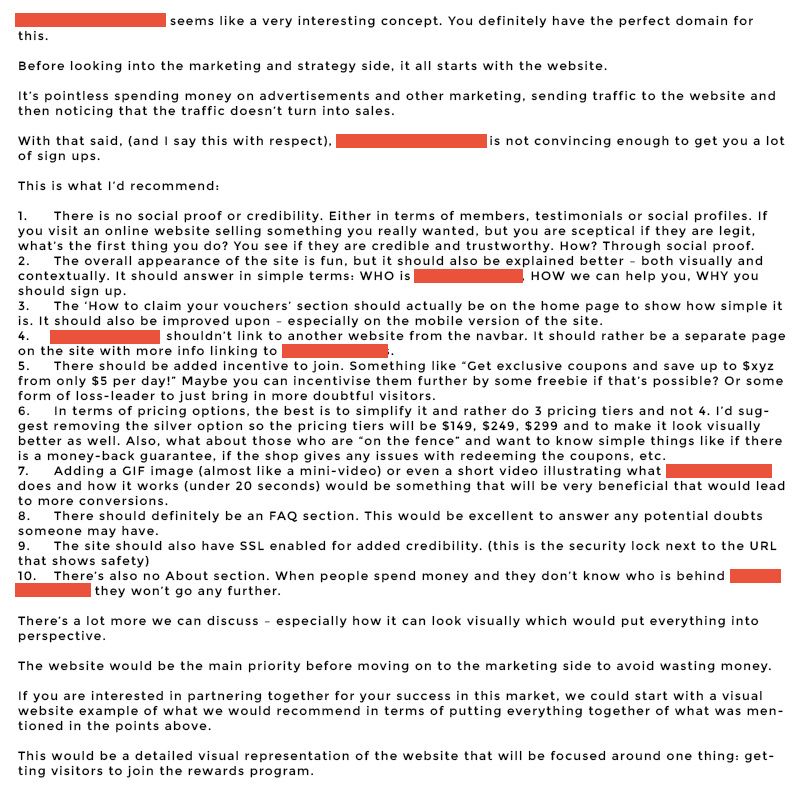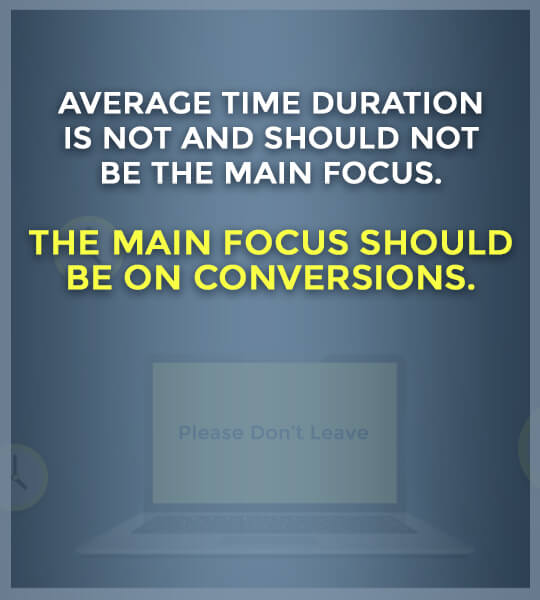How to Get Website Visitors to Stay on a Website Longer

Website owners all have one thing in common:
They want the website visitor to stay on their site for as long as possible.
But is this really true?
Let’s take a look at this topic in context:
If someone has a website that shows the weather in your city, does it mean their website is bad if someone leaves after 5 seconds?
No.
In fact, weather websites have some of the highest bounce rates and lowest average time on site statistics online.
(A bounce rate is a percentage statistic. Example: 100 people visit a website page, 25 of them leave the site and don’t click onto any other page, and 75 of them click on another page. The bounce rate is then 25%.
A low bounce rate is good. A high bounce rate is generally bad.)
If someone wanted to view the tennis scores, does it mean their website is bad if someone leaves after 5 seconds?
No.
Let’s say it’s a landing page – in this case an eBook download page.
(A landing page is a fancy term for a page with a specific desired action the website owner would like the visitor to take)
If it’s simple like my eBook page (link here), the average time on this page is less than 20 seconds. This isn’t bad because ultimately the goal is to get the visitor to download the eBook – not to have a coffee and look at this page for 10 minutes.
But if it’s something informative like a blog article for example, would we like the visitor to stay on that page as long as possible?
Of course.
What about the home page?
Generally speaking, the home page should have a low bounce rate and it shouldn’t be a priority to have the visitor spend the most time there.
The point of a home page is to get the visitor OFF of it and to click on another page.
Takeaway: Things need to be looked at in context. Don't just accept things written by 'experts' who say visitor duration is what counts. This is just a factor amongst many goals - not the only goal.
Now that we’ve established that spending more time on a website shouldn’t necessarily be the main focus, let’s ask the question:
Why Is This Important For You?
If you are going to create websites for clients, your main focus and concern should be on CONVERSIONS and getting the right message across to the website visitors.
You can’t just create websites that you think will look good or the owner might like.
Unless you are doing a design-related website or something unique related to the brand personality, you should just think about getting the business positive results. The way to do that is to make your main priority conversions.
I’m not saying websites that perform well need to look bad either. But if your main priority is just a pretty website then you are doing your client a disservice.
It’s not always about how long someone stays on the website. The question is all about whether the visitor makes the action the website owner would like them to take.
So let’s be practical.
How Do You Create a Conversion-Centred Website?
This depends on the business goals. Here are some common ones:
- A free call back
- A free consultation
- A free eBook
- A purchase
- Watching a video
- Subscribing to the newsletter
Sometimes all of them are the focus depending on where the visitor is in the sales funnel.
(A sales funnel is just a fancy term for how close the visitor is to buying the product/service.)
How Do You Measure If a Visitor Stays Long On a Website?
There are a few tools you could use for this, but I'll just discuss the main one:
Google Analytics
Google Analytics is a free tool to see the analytics/data of your website traffic. In short, you can see average time on site, unique visitors, how people are finding the website through certain keywords, which city they are in, popular pages, etc.
If you'd like to read more about how to install GA and how to understand it, click here.
Why Do People Leave Websites?
The truth is that you eventually leave every website you enter… (unless you are a Facebook addict that remains logged in 24/7)
But the correct question would be, how to get visitors to stay on a website longer?
There are obvious SEO benefits for this as well. Click here to read more about SEO.
Here are 4 (or 5) of the main ways to keep a website visitor on your page longer:
1. First Impressions
The truth is we all make quick snap judgements about people within 2 seconds of meeting them. This fact is no different when it comes to a website. Everything from the website loading speed, navigation, how the content is displayed, designs, relative information and more will either convince the website visitor to remain on the page or to leave soon after viewing it.
2. Related/Recommended Articles
If used properly, this can be very effective. If you've ever been on SmashingMagazine.com or Sitepoint.com, you'll notice there are almost a dozen related links directing to other articles throughout the article which makes it difficult to leave the website as you just want to keep reading.
3. Be The Best In Your Industry
This is a fluffy headline, but what I mean by this is to create something awesome. If it's a blog post, look at the competition and improve on where they are weak in answering what the visitor would like to know. Add images, add videos, add longer content and make it the best resource in that industry.
4. Add A Call-To-Action
A sad truth is that more than 70% of website visitors never return to the same website again. Obviously this can be debated, but that's an overall stat. To get visitors back on your website, have a clear call-to-action (an action you'd like the visitor to take) which will get them coming back in the future. The best way to do this would be a free eBook or a free course or a free download. Then you can email them new articles or information to get them back on your website.
5. Bribe Them With Money
Pay the visitor a lot of money to stay on your website.
Dealing With Clients
When you deal with clients and they say things like, “I want more visitors to my site, can you help me with that?”
Don’t be like everyone else and say “sure”.
It’s not about visitors… it’s all about the RIGHT visitors that are likely to make conversions.
It’s easy to get visitors… how? Just place Facebook ads targeting India and Bangladesh and pay groups/pages in whatever niche the website is in. You’ll see big numbers.
It’s not about that…
You need targeted visitors who are likely to complete the action you’d like them to on a website.
On a practical note, let’s say an interior decorating business asks you to help with their online presence like their website and general online marketing.
There are 3 paths here:
- You have to create the website from scratch
- The business has an existing website and you have to get the business traffic/visitors
- You have to create the website and get traffic/visitors
Here are the steps you should take (and the steps I follow):
- Find out what their main business goal is (in this case it would be to setup a free consultation)
- Look at their website and if it achieves the business goal
- If no, pitch them on why they need a new website or changes to their existing one
- If yes, move on to the next steps
- Ask how they are currently getting leads (visitors who book a free consultation)
- Figure out how to get more targeted leads
- Partner with them
- Make changes and improvements along the way
Here’s a portion of a recent email example that I sent to a potential client in the coupon/rewards niche (that turned into a client):

What Should You Do If You Make Suggestions That The Client Doesn’t Agree With?
These things happen. Clients won’t always agree to what you suggest. In this case, it’s best to use your discretion to see how you will move forward.
To give a personal example of where this happened with me, I created a website for a business that sells accounting services in a relatively small city/town.
After analysing his competitors, I made a firm suggestion that the website should focus around himself. He should be the ‘face’ of the business and would write blogs in his name, interact in finance groups, etc.
The reason why I suggested this was because people like doing business with people. Not a small business trying to appear like a big corporation. This is not always the best suggestion of course, but in small towns and cities, this is always the best way to differentiate yourself from tight competition in a niche like financial services for example.
I gave examples of where other websites/businesses in more popular cities were using this strategy and were dominating their market to back up my suggestions.
Long story short is that he wanted to appear like the corporates and didn’t want to be the ‘face’ of the business due to insecurities. It’s fair, but I didn’t agree with this as it makes things so much more difficult now.
So I agreed to make the website which is focused around a free consultation booking and free call back with the corporate feel, but I didn’t agree to on-going marketing as I couldn’t fully support the website.
I do think I would’ve been able to get him more clients, but I wanted to get him a lot more and really grow his business. He was content with average growth and I wasn’t.
Now, some of you may be happy with everything your client suggests and partner with them – nothing is wrong with that, but this is my personal preference around creating websites that work and growing their business.
When you deal with clients on this topic, you need to be confident. If you are charging low amounts for websites, read this article.
For those who are charging decent amounts or would like to charge decent amounts, read on.
In order to be focused around conversions, you need to know about it first.
After all, how can a pilot be a pilot without learning how to fly a plane?
It’s no different with web designers/developers.
Don’t feel overwhelmed with this. If you study basic CRO techniques and read case-studies of what works, you’ll be more confident in your suggestions. You don’t need a qualification for this.
It really makes me sad and somewhat irritated when I see that a business paid a good amount of money for a website and yet their website sucks and doesn’t even fulfil the basic needs of why the business is actually creating the website in the first place.
If they hired someone on Fiverr or paid a cheap price for their site, then I can understand.
But if you charge good amounts (which you should) then the outcome needs to get results. It’s only fair and it’s the right thing to do.
So how do you get to a place where you can deliver better results?
Well, how would someone learn to ride a bicycle? By spending the time in riding it of course.
It’s no different with creating effective websites that get results.
The more websites you create and the more you keep learning about improvements, the better positioned you will be in this field to create websites that work.
This requires constant testing.
Play around with different images, changing certain sections, using different headings, sub-headings and content, changing colors of buttons or CTA’s.
For those who would like a 'detailed,' helpful infographic on this topic, here it is :)

I hope this article helped you at least understand the basics on this topic.
If you’d like to learn more about this topic, click here.
As always, keep moving forward and keep learning.
Kyle
 by Kyle Prinsloo Last updated Sep. 14, 2017
by Kyle Prinsloo Last updated Sep. 14, 2017






